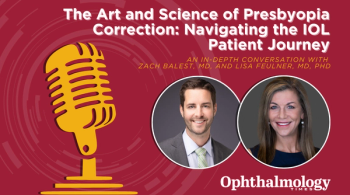
MIGS continues to innovate, secure place in glaucoma
Treatment options expand for patients along continuum of mild-to-severe disease
MIGS continues to be a surgery option for glaucoma and is a key technology disrupter in ophthalmology.
Reviewed by Michele C. Lim, MD
MIGS study guidelines
FDA guidelines for study design of MIGS devices recommend that the primary endpoint be the percentage of subjects with at least 20% reduction in mean diurnal IOP from baseline and that the secondary endpoint should be the mean diurnal IOP change from baseline. These guidelines were followed in some of the studies Dr. Lim discussed during the
Comparing studies
Focusing on the iStent inject, she discussed two prospective studies in which the system was combined with cataract surgery.
However, in both studies the mean IOP remained in the mid-teens at follow-up visits 3 to 4 years postoperatively. Dr. Lim also described two studies of the iStent inject implanted as a standalone procedure. Fea et al. reported that 95% of patients (using no medications) reached the primary endpoint versus 92% of patients taking two medications.
In a noncomparative study, Voskanyan et al. found that 72% of patients (using no medications) achieved the primary endpoint. The mean IOP reduction at 12 months was –13 mm Hg for patients in the iStent cohort and –13.2 mm Hg for those using medication in the Fea et al. study and –14.7 mm Hg in the Voskanyan study. The most common adverse events reported in these studies were that the iStent was not visible (1% to 13%), the iStent was obstructed (1% to 3%), or that the IOP was elevated (10%).
The Hydrus microstent, which sits in and dilates
At 24 months, the washed out mean diurnal IOP was 17 mm Hg for the combined procedure patients and 19 mm Hg for those undergoing cataract surgery alone; Dr. Lim noted a medication advantage favoring the Hydrus patients; at 24 months, 73% of this group was not using any hypotensive medications compared with 58% of the cataract surgery group.
Peripheral anterior synechiae was a notable adverse event in the Samuelson et al. study and occurred at a rate of 18% (14.9% nonobstructive, 3.8% obstructive). However, a post-hoc analysis suggested that it was not related to IOP outcomes. Dr. Lim also discussed bleb-forming MIGS, which require the use of mitomycin-C to suppress fibrosis.
These results were relatively good, especially given the patient population. “When you compare the outcomes to
Dr. Lim also added that the study’s safety profile seemed reasonable but there is a significant needling rate (32%). Early published data on the InnFocus subconjunctival microshunt are promising, according to Dr. Lim. Batlle et al. conducted a retrospective study in which 9 of the 14 patients received the microshunt as well as
Three-year follow-up data indicated that treatment resulted in profound pressure lowering, almost on the level of trabeculectomy. The mean medicated IOP was 10.7 mm Hg, a 55% drop from the preoperative level. A caveat to these results is that the study was retrospective, it had a small sample size, and the patient population was a mix of those receiving the shunt alone as well as in combination with cataract surgery.
Looking ahead
Despite bumps in the road, such as the voluntary recall of the
Disclosures:
Michele C. Lim, MD
E: [email protected]
This article was adapted from Dr. Lim’s presentation at the 2019 meeting of the American Glaucoma Society. Dr. Lim is a speaker for Alcon Laboratories and an investigator for Santen.
Newsletter
Don’t miss out—get Ophthalmology Times updates on the latest clinical advancements and expert interviews, straight to your inbox.















































.png)


